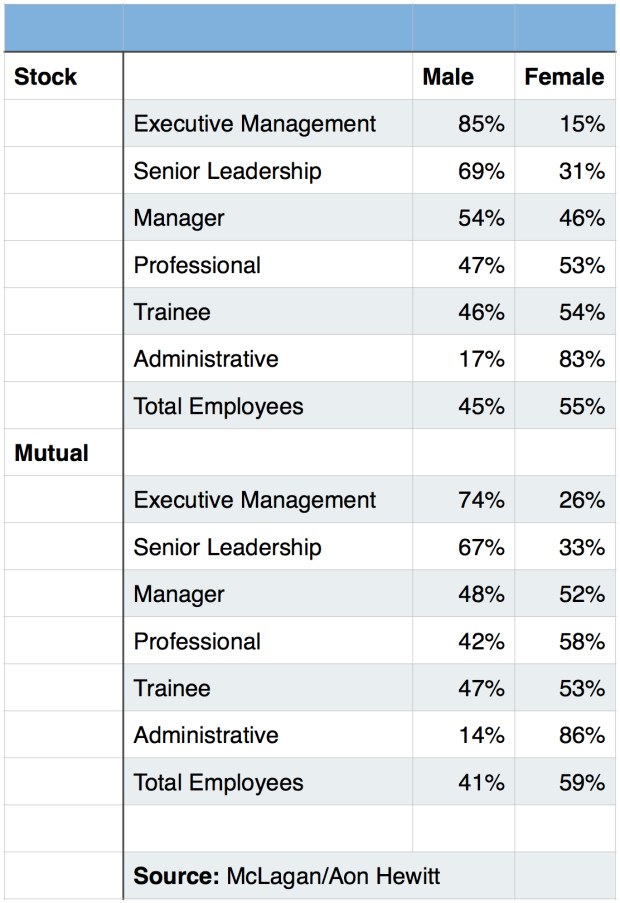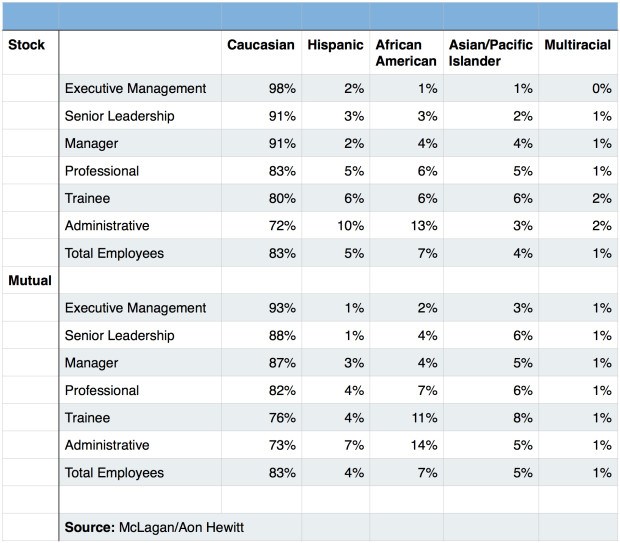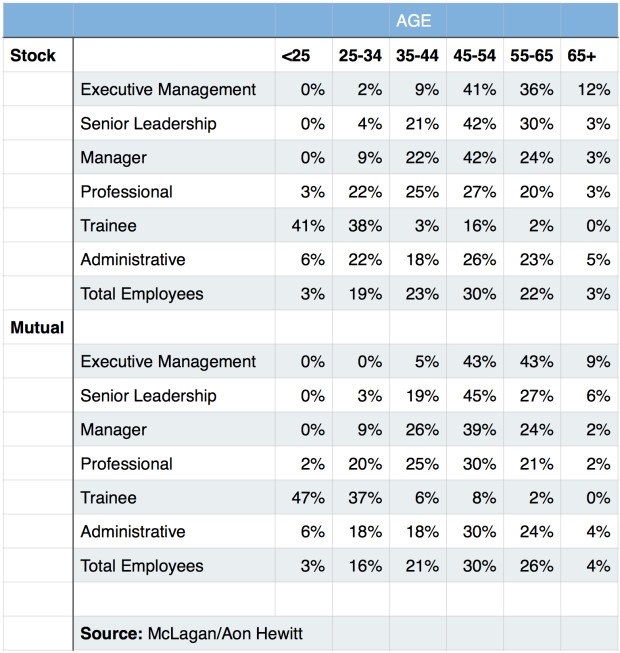For those hoping to make the insurance industry leadership and rank and file more diverse and attract younger employees, a wide-ranging study quantifies how much of a challenge lies ahead.
About 85 percent of executive leadership at public companies in the sector is male. At mutual insurers, the number reaches nearly 75 percent, according to the report from McLagan, an independent subsidiary of Aon Hewitt, a division of Aon. Most company leaders are also white—98 percent and 93 percent of executive management are Caucasian at stock and mutual companies, respectively, the study found.
Insurance employees and executives are also older—mostly age 45 or above.
Study author Kaitlyn Isley, a McLagan senior analyst, said that her firm pursued the study in the hopes of adding additional insight to a topic that has been on the minds of industry leaders for some time.
“At different conferences and roundtables, diversity was a forefront topic, and companies were trying to discuss how to bring diversity into the insurance industry,” Isley told Carrier Management. “We did it to shine some light and give some [perspective] to human resources and compensation people.”
McLagan surveyed 65 insurers, more than 50 of which are in the property/casualty industry, beginning in late fall. The firm initially published its results in early February.
The results, she said, reinforce a conclusion that many have already made.
“The insurance industry is not very diverse. You can see that with the results,” Isley said. “From that, it [is a question of] how do we address the issue.”
“From this,” Isley added, “we are hoping some conversations start.”
To be sure, others have looked at the diversity issue in insurance. In late 2015, Willis Great Britain CEO Nicholas Aubert (Willis is now part of Willis Towers Watson) called for an embrace of diversity in the insurance/reinsurance industry. Back in 2013, research from Saint Joseph’s University showed gender diversity in leadership is lacking across all segments of the industry and that women at that time held just 6 percent of top executive positions across all industry segments.
The new McLagan survey/study suggests that the gender diversity situation hasn’t improved all that much in the executive suite, though the number improves down the ranks.
Executive Leadership Less Diverse Than Rank and File
In stock companies, for example, the executive management comes in at about 15 percent female. That rises to 31 percent for senior leadership, 46 percent at the manager level, 53 percent at the professional level, 54 percent at the trainee level and 83 percent at the administrative level. When the rest of the rank and file is factored in, the results look more diverse—with the breakdown 45 percent male and 55 percent female.
For mutual companies, 26 percent of executive management is female. That rises to 33 percent for senior leadership, 52 percent for managers, 58 percent at the professional level, 53 percent for trainees and 86 percent at the administrative level. When everyone is factored in from top to bottom, mutual insurers in the survey employ 41 percent males and 59 percent females.
What doesn’t change going from the C-level to rank and file is the mix of Caucasian employees versus all others.
In stock companies, the number of Caucasian employees remains above 90 percent through the manager level. It sits at 80 percent or above for the professional and trainee level and 72 percent at the administrative level. For mutual insurers, the number drops from 93 percent at the executive management level to 88 percent for senior leadership and 87 percent for managers. Caucasians fill 82 percent of professional jobs and 76 percent of trainee positions. They encompass 73 percent of administrative positions.
The difference in each situation is filled by small numbers of Hispanic, African American or Asian/Pacific Islander/Multiracial employees, accoring to the McLagan survey.
For both stock and mutual companies, a solid majority of employees at nearly ever level land between ages 45 and 65.
“Over half of the workforce is over the age of 45,” Isley noted.

Solutions Vary
Industry leaders have noted this, too. P/C organizations including The Institutes, MyPath, Valen Analytics, The Jacobson Group, INVEST and PCI are part of an ongoing effort to attract more millennials to insurance careers. They’re using outreach as well as Twitter, YouTube and other social media in an effort to make this happen.
As the McLagan study noted, companies themselves are starting to address diversity issues themselves, but there is a long way to go.
Six percent of companies that took part in the survey said they have a chief diversity officer. Of the ones that don’t, 7 percent said they plan on hiring one in 2016. Also, nearly half said they have a diversity strategy in place or are developing one.
“The chief diversity officer is not a common job yet,” Isley said. “In the coming years, it will be. But as of right now, most companies are not necessarily addressing the issue.”
Isley said larger companies may need this as part of their strategy, but smaller companies can address the issue as part of the regular human resources office.





















 California Workers Comp Combined Ratio for 2024 Highest in 20-Plus Years
California Workers Comp Combined Ratio for 2024 Highest in 20-Plus Years  Surge of Supercharged Hurricanes Prompt Call for Cat 6 Classification
Surge of Supercharged Hurricanes Prompt Call for Cat 6 Classification  Executives on the Move at Liberty Mutual, Cowbell, W. R. Berkley
Executives on the Move at Liberty Mutual, Cowbell, W. R. Berkley  Insurance Costs, Climate Concerns Factor Heavily in U.S. Home Buying Decisions
Insurance Costs, Climate Concerns Factor Heavily in U.S. Home Buying Decisions 










